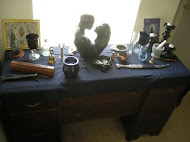The following article contains information that might be inappropriate for the very young or very foolish. Any information is provided with the understanding that the author warns against the use of any of these substances unless medically qualified.
Some of the earliest records that make reference to the use of substances to affect the mental and physical condition have been about witches and Witchcraft. The practitioners of this craft, most often women, were frequently consulted by individuals who desired a potion or charm that would ward off evil, attract love or heal an illness. Their knowledge of the uses and misuses of plants was well known and many modern writers acknowledge that it is these individuals who developed and retained, through history, the herbal lore which has been extensively employed by modern medicine and pharmaceutical companies. Often we are unaware of the history of the drugs we take so much for granted in our lives. A brief review of the origins of drugs such as aspirin and digitalis demonstrates that these drugs have plant origins and were in use long before modern medicine discovered and isolated them. Foxglove, for instance, (also known as fairyglove and witch's glove), was the source of digitalis, the drug which has saved the lives of many people suffering heart conditions. Digitalis was discovered by Dr. William Withering, in his book, 'An Account of Foxglove and its Uses', (1785), he acknowledges his debt to Witchcraft herbal lore in leading him to the use of foxglove for assisting those with Heart conditions.Tradition has it that witches would often go out on nights of a full moon to collect strange plants. Rather than being an obscure magical ritual, the collecting of plants at night-time and when the moon is full has a basis in plant biology. Many of the plants employed by witches have their highest active drug content at these times. If one were to remove some of the more obscure magical aspects of Witchcraft, a deep understanding of herbal lore, medicine and psychology is revealed. Our society, and more specifically modern medicine and the multimillion dollar pharmaceutical industry, owe much to the traditions of Witchcraft and the knowledge passed through the centuries by these practitioners of an ancient and persecuted art.
Nights of the full moon are associated with witches and as indicated above it was often at these times when plants were collected. The full moon has special significance for witches and at certain times of the year it coincides with the "Witch's Sabbath", when witches are said to gather to worship their God or Goddess. During these meetings it is reported that ritual ointments, made principally of plant substances, were and are employed to promote particular experiences.
Another common theme in Witchcraft folklore is witches flying on broomsticks to go about their nocturnal deeds. In a number of texts there are frequent references to witches flying and meeting the incarnation of their particular Goddess/God. While some may argue that these accounts were extracted by the cruel tortures of their persecutors, for example, use of procedures in the 'Malleus Maleficarum (1486), there are some that appear to reflect what many witches believe they have actually experienced. A number of written accounts are available which speak of the use of ointments or unguents to enable a witch to fly. They include; "The Book of the Sacred Magic of Abremelin The Mage" (1458), by Abraham the Jew, and 'De Miraculis Rerum Naturalium', (1560) by Giovanni Battista Porta, (both of these texts are in the British Library however access to them is restricted). In the account of Abraham the Jew, he is provided an unguent by a young witch that after rubbing on the principal pulses of the feet and hands, created a sensation of flying. Porta's account has a section which is entitled 'Laiarum Unguenta', "Witch's Unguents", in this he describes the recipe of flying ointments.
An investigation of these accounts and the ceremonial ointments used by witches at their Sabbaths, reveal a number of plants which have extreme physical and psychological effects when taken internally or rubbed on the skin. Many of them are extremely poisonous and the reports of their use by rubbing into specific areas of the body or all over, demonstrates a recognition of the lethal properties of these plants if taken internally.
The use of plants to promote a sense of flying, "out of body experience" and the ability to convene with the spiritual world, is a recurrent theme in many ancient religious practices. The shamans of Native American cultures, and priests and priestesses of religions throughout the world share the witch's use of specific plants to extend the normal boundaries of human experience. While there are a number of recipes for flying ointments, there are many difficulties in identifying the plants exactly. There was no universal plant classification system during these times, many plants share common names or are confused with others, and finally the chances of mistranslating from these ancient texts are high. Despite these problems a number of plants were known to be associated with witches and even the common names of some plants provide a clue to their uses. Certain plants occur regularly in recipes of flying ointments and witch's Sabbath ointments. These include:
- Deadly Nightshade (Atropa Belladonna)
- Monkshood (Aconitum Napellus)
- Henbane (Hyoscyamus Niger)
Others that appear include:
- Thornapple (Datura stramonium)
- Poplar
- Foxglove
- Poppy
- Cinquefoil
- Smallage
- Woody Nightshade
- Hemlock and Water Hemlock
- Parsley\
- Wild Celery (Apium graveolens)
At times there is mention of more exotic elements, for instance the fat of human babies and bats blood. These are most likely sensationalist reports or there to "spice" up the magical aspect of the recipe. There is also a possibility that these terms refer to a specific herb. For example, 'Gravel Root' is not the root of a piece of stone in your driveway, but rather another name for Meadowsweet. Many herbs have had colorful folk names attached to them throughout the years. (For a great cross-reference tool, visit Herbal Cross Reference. This site offers a wonderful tool to allow you to translate "folk names" to common or scientific names.) However the use of a fat, probably from an animal, was employed to provide an oily base for the crushed plants, enable its application on the skin and as a medium to prevent the rapid evaporation of the volatile plant alkaloids.
Despite many witches being aware of mushrooms and fungi that promote altered states, they have not been mentioned in any of the texts on flying/sabbath ointments. The reproduction of flying ointment recipes and their application has promoted similar experiences of flying, out of body experience and meeting fantastic gods and demons. Dr Erich Peuhart, of the University of Gottingen, Germany conducted experiments on himself and a colleague to investigate the effects of flying ointments, his subsequent report was similar to the accounts provided by witches, and included flying through the air, landing on a mountain top, orgiastic rites and the appearance of monsters and demons.
Many of these experiments have been conducted by medically trained individuals, current practitioners of Witchcraft and a number of people seeking interesting and novel experiences. It is uncertain if the similarities of their experiences are a feature of the plant substances used or their expectancies before they used the drug. The ready availability of many of the plants containing the active constituents of flying ointments, are a potential danger to individuals who have a desire to experiment on themselves. Given the lethal properties of these plants and the inability to ascertain dose, it is an activity left to the experienced, trained or foolish. It should be noted the internal administration of most of these plants is extremely dangerous, this point being reflected in their use externally by witches.
Belladonna, (Atropa Belladonna), or commonly known as deadly nightshade is relatively rare in the UK. In Britain it is usually found in chalky soils, shaded areas and waste ground or old ruins. It is extremely poisonous and has been employed for many centuries for beneficial and less beneficial purposes. According to folklore it is a plant that belongs to the Devil, who tends it, being diverted from this duty only on the night of the Walpurgis night Witches Sabbath. The name belladonna, "beautiful lady", is thought to derive from its use by Italian ladies, to dilate the pupil of the eye to make them more attractive. The generic name, "atropa", is derived from the Greek, Atropos, one of the fates that held the shears to cut the thread of human life. The properties of belladonna depend on the presence of hyoseyamine and atropine, the root is the principle source of preparing tinctures, however, the whole plant including the berries contain these alkaloids. Atropine has been used in opthalmology for the dilation of the pupil and was used as an antidote to opium. It was also used to lessen pain and inflammation. It has anti spasmodic activity and was used for asthma and whooping cough. It increases the rate of the heart by approximately 20 - 40 beats per minute. In poisonous doses it causes paralysis and excitement and delirium.
A very common plant in the U.K. growing in hedgerows and shaded areas which has frequently been confused with Deadly Nightshade. Its active constituent is solamine which acts narcotically, in large doses it causes paralysis. It slows the heart and respiration, reduces temperature and causes vertigo and delirium, eventually convulsions and death. Woody nightshade was used widely for a number of ailments including rheumatism, fever, inflammation and jaundice. It was believed to guard against the evil eye and has been revered for thousands of years - a necklace of the berries was found in Tutenkahmun's tomb.
Aconite is a plant which was introduced to England long ago. Reports of it are included in manuscripts of the tenth century downwards. it is found growing wild in western counties of England and South Wales and was popular as a flowering garden plant. The poisonous properties of aconite have been used to coat arrowheads for use on humans and animals. Its medical uses was mainly restricted for the alleviation of muscular and rheumatic pain, applied externally to the affected area. A number of alkaloids have been identified within aconite but the group which is believed responsible for its medical and poisonous activity are the aconitines. Aconite is extremely poisonous and the symptoms of poisoning begin with numbness in the mouth,crawling sensations on the skin, vomiting, stomach pains, labored breathing, irregular and weak pulse, giddiness and staggering, eventual cardiac arrest or asphyxiation. The mind remains clear. In cases of poisoning artificial respiration and stimulants are indicated.
Hemlock is a common plant in the U.K. found in meadows, banks and hedge banks. It has some similarities to parsley but is distinguished by blood red markings/spots on its stem and root. All parts of the plant contain a very strong poisonous alkaloid called conium. Conium (produced by extraction of the juice of hemlock) is a narcotic, sedative and antispasmodic. Its medical use in the past was to treat coughing, epilepsy or any over activity of the muscles. In poisonous doses it produces loss of sensation, complete paralysis of striated muscle, loss of speech, the respiration slows and eventually stops. Death results from asphyxiation. During this process the mind remains clear and unaffected. The most famous account of the use of hemlock is the poisoning of the ancient Greek philosopher, Socrates. Conium is a highly volatile plant alkaloid and loses its potency rapidly. Heat destroys it. In cases of poisoning artificial respiration and the use of stimulants are indicated.
Relatively uncommon in England, but common in America, thornapple is strongly narcotic and doses lead to dilation of the pupils, giddiness, delirium and mania. The active constituents are the same as Belladonna, i.e.. hyoseyamine and atropine, but in smaller concentrations and its medical uses are the same as belladonna. Its effects on coughing and respiratory conditions being slightly stronger.
It is relatively common in the UK. growing in shaded areas and has a long history of use and mythology. In Greek legend the dead in Hades were crowned with Henbane as they wandered beside the Styx. The plant was used in magic and diabolism for its power of causing delirium and hallucinations. In poisonous doses poor vision, dizziness, sleepiness is followed by delirium and convulsions. The active constituents are hyoseyamine, atropine and hyoseine. Similar to belladonna in its medicinal uses, however the added presence of hyoscine gives it the properties of reducing secretions and relax spasm of involuntary muscles. It has been employed in hysteria, pain and rheumatism. Henbane's sedative action does not give as much rise to the delirium associated more with high concentrates of atropine. It was also used extensively in insane asylums for treating mania and delirium tremens.
Common in England, growing best in sunlight, this plant has extremely powerful action on the heart. Digitalis contains a number of glucosides, three of which are cardiac stimulants; digitoxin, digitalin and digitalun. The other glucoside is digitonin, a cardiac depressant. Digitalis has been used from early times for its properties on the heart and circulation. Its first action is to increase blood pressure due to contraction of the heart and arteries. The pulse slows and regulation of an irregular pulse should occur. In toxic doses it causes disturbances of the senses, blurs the visual field. Low dose poisoning leads to slow and irregular pulse, higher concentrations of poisoning leads to rapid heart beat and arrest. Tradition has it that foxglove is a plant of women and of the Goddess Diana.
I strongly urge people not to experiment with any of the plants mentioned, as they are extremely poisonous.
Disclaimer: No one involved in this blog or its contents may be held responsible for any adverse reactions arising from following any of the instructions/recipes on this list. It is the reader's personal responsibility to exercise all precautions and use his or her own discretion if following any instructions or advice from this blog.















No comments:
Post a Comment